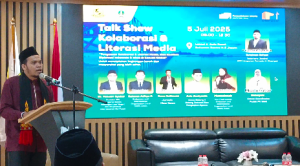 AMERICA AND AUSTRALIA DISCOVERED BY MUSLIMS HUNDREDS OF YEARS AGO?
AMERICA AND AUSTRALIA DISCOVERED BY MUSLIMS HUNDREDS OF YEARS AGO?
by Syarif Hidayat*
Who Really First Discovered America : a Spanish explorer Christopher Columbus in 1492, a Chinese Muslim Admiral Zheng He in 1421 or a Central Asian Muslim scholar Abu Raihan al-Biruni in 1037? And Was Australia also discovered by Muslims hundreds of years ago?
Every time the United States celebrates Columbus Day, a federal holiday annually on the second Monday of October in honor of Christopher Columbus, the question always arises: Who really discovered America? Since many textbooks and historical annals of the preceding five centuries give Christopher Columbus the credit for “discovery” of the new world, one might wonder why anyone would bother asking such a question.
Also Read: Nuclear Technology: Harm and Benefit from the Qur’anic Perspective
An article titled “Who Discovered America? Not Christopher Columbus, That’s for Certain” published in http://voices.yahoo.com , says “One would think it quite evident who discovered America. But one would be wrong, because Christopher Columbus did not discover America, no more than he proved that the world was not flat.”
Sailing off at the behest of the king and queen of Spain to find a shorter passage to India may have been a brave thing to do, but Christopher Columbus’ voyages and “discoveries” are questioned today. Archaeology and common sense have given us alternate events that predate Christopher Columbus and that tell us that he wasn’t the first human or the first European to set foot on an American shore.
First, common sense tells us he wasn’t the first human in the Americas due to the fact that there were already “Indians” in the Americas. In fact, Christopher Columbus, after figuring out he was not in India, decided that slavery, subjugation, and religious oppression were the answer to the question of his discovery.
But before all that, before the European hordes that would descend on the native populations of North and South America due to Christopher Columbus’ discovery of a New World to colonize and exploit, others set foot on American shores. In fact, there exists cartographic evidence, according to cartographic expert Armando Cortesao, that Portuguese explorers visited the Americas and mapped the area in 1424, but other than the map itself, there is no information.
Also Read: Gaza Cries Out, the World Stays Silent: A Wounded Humanity
It also known that Norse explorer Leif Erikson set foot in the Americas long before 1492, according to Icelandic sagas, having pulled his Viking longboat into the shallows off modern Newfoundland, Canada. Archaeologists found remains of a Viking-type settlement in 1963. It is believed to have been extant around 1000 A.D., roughly half a century before Christopher Columbus “discovered” America.
To be clear, there were native Americans on the continent then, as well. So the “discovery” of America was still only a European discovery.
But there are many who believe seafaring peoples of the past, such as the Phoenicians, who have nautical records that stretch back to 1600 B.C., could have and did travel to the New World.
The aforementioned cartographer, Cortesao, believes that many of the islands on ancient maps, long thought to be mythological or imaginary, were actual places. Many of them, he asserts, correspond to real geographical locations, leading Cortesao and others to believe that Erikson and others were late to the game of discovering the Americas.
Also Read: Indo Defence Expo and Forum; Sharing Responsibility of Humankind and Environment
So who discovered America?
Certainly not Christopher Columbus. But if one disqualifies the argument of the migratory peoples that made their way to the Americas millions of years ago via water or land bridge and approaches the question from a European, African, or Asian standpoint, it can be argued that it may have been Leif Erikson and his band of Vikings. But it could have been an earlier group of brave and/or foolhardy seafarers from any number of lands, like Phoenicia.
But Columbus Day need not be about who discovered America. It can just as easily be about the man who helped popularize the idea of European expansion into the New World. But don’t expect a Native American to salute the Genoan sailor anytime soon, no matter what position he takes in the line of discoverers that made it to the Americas.
Another article titled: “Who Discovered America?” published in www.buzzle,com says “America, also known as the New World is claimed to have been discovered by many people at many times. However, one can’t say for sure who discovered America first. Therefore, it is worth going through the information given below which provides some interesting insights on the topic.”
Also Read: Safiya Saeed: From Somali Migrant to First Hijab-Wearing Mayor of Sheffield
America had often been discovered before Columbus, but it had always been hushed up. The above line by famous Irish novelist, Oscar Wilde makes an important point about discovery of America. The claims about discoveries hold less significance in today’s world where, even scientific theories of Darwin are being challenged. Questions like who discovered what might be important, only from the point of maintaining records. However, the facts and records available to us are likened to links of broken chains, used for reaching a consensus on discoveries.
 Spanish Explorer Christopher Columbus
Spanish Explorer Christopher Columbus
It is a commonly held belief that Christopher Columbus discovered America. This fact however, can neither be ruled out nor accepted blindly. In October, 1492, Columbus reached the shores of America when he was in search of India. There are few historians who believe that it was not America’s mainland that Columbus reached in 1492. The place was actually an island of Bahamas. Columbus returned to Spain after this voyage.
Later on in 1497, Amerigo Vespucci, another Italian explorer claimed to have discovered America. Martin Waldseemuller was the first to name this huge land mass as America. However, one cannot say for sure that Columbus and Amerigo Vespucci were the first to discover this huge continent. The Chinese claim that they discovered America long before the voyages undertaken by Europeans sailors. So who really discovered America? Let us find more on the topic through details about voyages taken by people other than Columbus and Amerigo Vespucci.
Also Read: Why Food Safety is Essential During Hajj Services?
Chinese Muslim Admiral Zheng He
Sheila Musaji* in her article titled “Did Chinese Muslims discover America before Columbus?” published in http://theamericanmuslim.org writes “Robert Spencer posted an article CAIR refuses to explain its claim that Muslims discovered America. He says:
This is a consistent pattern: Islamic supremacist spokesmen in the U.S. regularly make unsupported claims and then refuse to back them up. The most egregious example of this is the regularly-repeated Big Lie that counter-jihadists quote the Qur’an out of context, ignore or deny its peaceful passages, and generally misrepresent Islamic teaching—the element that is lacking every time such claims are made is an interpretation of the Qur’an’s violent passages, and an explanation of their “context,” that renders them benign.”
He then posts a story from the Daily Caller, a news source of about the same integrity as those you see at the supermarket checkout. That Daily Caller article claimed that:
Also Read: Indonesia Sign Language Mushaf Qur’an; A Sustainable Gift in Celebrating Pancasila Birthday
“There are historical accounts according to which the Muslims preceded Columbus, who is said to have discovered the U.S.,” claimed Nihad Awad, the co-founder of the Council on American Islamic Relations.
“Some documents and accounts indicate that Muslim seafarers were the first to reach the U.S., [so] the bottom line is that Islam played a part in the establishment and development of the U.S.,” Awad told the Saudi interviewer, in an interview in a New York studio.
CAIR did not respond to The Daily Caller’s request for an explanation of Awad’s comments, which were recorded by the Middle East Media Research Institute.
No one is required to respond and provide an explanation. Especially, when they are simply stating facts known to anyone with any knowledge at all about history. Nihad Awad said that “some documents and accounts” make this claim. And, that is indisputable. You might dispute the claim itself, but not that such claims exist.
Also Read: Leila Khaled, The Icon of Palestinian Women’s Resistance
 Admiral Zheng He May Have Landed in America Before Columbus
Admiral Zheng He May Have Landed in America Before Columbus
On Columbus Day in 2012, a FaceBook site “Don’t Hate, Educate” posted a brief article Who discovered America?. They note:
In 1421, more than half a century before Columbus, a Chinese Muslim Admiral named “Zheng He” landed on American shores. He’s the same great navigator who was celebrated in the opening ceremony of Beijing Olympics on 8 August, 2008.
The British submarine engineer and historian Gavin Menzies gave an astounding seminar on March 15, 2002 to the Royal Geographical Society in London, with evidence proving that Zheng He, a Chinese Muslim navigator in the Ming dynasty, beat Columbus by more than 70 years in discovering America. Imagine 6 centuries ago, a mighty armada of Zheng He’s ships crossing the China Sea, venturing west to Ceylon, Arabia and East Africa with giant 9-masted junks escorted by dozens of smaller ships.
Also Read: The Twilight of the Zionist Israeli State
The crew alone totaled more than 27,000 sailors and soldiers on 317 ships. They set sail in 7 great expeditions from 1405-1433. Zheng He’s flag ship was 400 feet long, much larger than Columbus’s Santa Maria which was only 85 feet lon. The Muslim Heritage site is also a very rich resource for researchers and educators on Muslim contributions to human civilization in every field imaginable: mathematics, agriculture, military science, nature, medicine, economy, geography, philosophy, art, social sciences and a lot more…check it out:
I found this fascinating, and did a little more digging. I discovered a NY Times article Did Chinese beat out Columbus? which discussed new discoveries that added weight to the argument made by Gavin Mendies in his book about Zheng He “1421: The Year China Discovered America” The NYT article says:
“1421: The Year China Sailed the World,” in Singapore in a special tent near the Esplanade (until Sept. 11), is primarily a celebration of Admiral Zheng He’s seven maritime expeditions between 1405 and 1423. With a fleet of 317 ships and 28,000 men, Zheng He is generally acknowledged as one of the great naval explorers, but how far he actually went remains a matter of dispute.
With original artifacts, videos and interactive exhibits, “1421” aims to take visitors through Zheng He’s life story, setting the historical and economic context of his voyages. Against this factual background, Menzies’s theories are presented, along with new evidence, mainly maps, backing his claims.
Also Read: Prof. Abdul Fatah El-Awaisi and the Intellectual Roadmap for the Liberation of Al-Quds
The exhibition starts in Hunnan (China) in 1382, with a narrative space giving some background on Zheng He’s youth. Zheng, a Chinese Muslim, was captured as a child in wartime by the Ming army and made a eunuch to serve at court. He became a scholar and a trusted adviser to the third Ming emperor, Zhu Di, who sent him on a mission to “proceed all the way to the ends of the earth to collect tribute from the barbarians beyond the seas.” …”
So, Admiral Zheng is at least one Muslim that might have sailed to America before Columbus. The portrait above of Admiral Zheng He is from a Sydney Morning Herald article about a documentary on his life.
This is not the first time that Spencer, and his partner in hate, Pamela Geller have objected to any suggestion that Muslims might have been here either before Columbus, or even at a very early date.
According to Sheila Musaji, in the article Moriscos, Marranos, Columbus, and Islamophobes, I discussed many such “historical accounts”. In that article I noted that “There are many theories about Norse (Leif Erickson), Irish (St. Brendan), Chinese, Phoenician, African, Arab, Japanese, etc. groups having reached North or South America prior to Columbus. None of these claims can be proven absolutely, and some have more evidence than others to be considered as possibilities. There is certainly no supremacism involved in believing that any of these might be true.”
Also Read: Dr. Joserizal Jurnalis: Founder of MER-C and Indonesia’s Humanitarian Icon on the Global Stage
The full article contains many links to sources.
Muslims, the Irish, Norsemen (Vikings), Africans, Japanese, all sorts of people may have landed before Columbus. So what! Perhaps, over time we will discover hard evidence that proves some or all of these possibilities to be true or false. Many Norwegians think Leif Erickson was the first “European to set foot on American soil in 1001”. Perhaps they are correct.
The only thing we know for certain is that the Native Americans/First Nations were already here.
*(Sheila Musaji is the founding editor of The American Muslim (TAM). Sheila received the Council on American-Islamic Relations 2007 Islamic Community Service Award for Journalism, and the Loonwatch Anti-Loons of 2011: Profiles in Courage Award for her work in fighting Islamophobia. Sheila was selected for inclusion in the 2012 edition of The Muslim 500: The World’s 500 Most Influential Muslims published since 2009 by the Royal Islamic Strategic Studies Centre in Amman, Jordan. Biography You can follow her on twitter @sheilamusaji (https://twitter.com/SheilaMusaji)
 Central Asian Muslim scholar Abu Raihan al-Biruni
Central Asian Muslim scholar Abu Raihan al-Biruni
A Staff Writer of Illumemagazine in an article titled “Was a Muslim scholar the first to discover America?” says “For centuries, the world has given Spanish explorer Christopher Columbus to be the man who discover the Americas (never mind the people who already lived there). However, new research shows that Central Asian Muslim scholar Abu Raihan al-Biruni discovered the continent centuries before Columbus. This theory was proposed in around 1037, by which point al-Biruni would have been 70 years old, and perhaps too old to travel it himself.
Writing in History Today, S. Frederick Starr says al-Biruni, born in what is modern-day Uzbekistan was the first person to officially suggest that a landmass existed Europe and Asia. Al-Biruni’s expertise on geography and mapping led him to conclude that Europe, Africa and Asia, only accounted for two-fifths of the world.
Starr writes that al-Biruni’s knowledge of both Middle-Eastern and Indian languages, as well as being trained in mathematics, astronomy, mineralogy, geography, cartography, geometry and trigonometry under great scholars like Ahmad al-Farghani, gave him deep insight into the sciences of various fields and civilizations. Al-Biruni also mapped the latitudinal and longitudinal locations of various cities in central Asia, India, the Middle-East and the Mediterranean.
Al-Biruni was one of the most important figures in developing Greek science. The work of al-Biruni’s teacher al-Farghani, is thought to be the basis for Columbus’s own explorations. Al-Biruni also provided an estimation of the earth’s circumference, only off by 10.44 miles from modern measurements.
There is certainly no supremacism involved in believing that any of these might be true:
Muslims, the Irish, Norsemen (Vikings), Africans, Japanese, all sorts of people may have landed before Columbus. So what! Perhaps, over time we will discover hard evidence that proves some or all of these possibilities to be true or false. The only thing we know for certain right now is that the Native Americans/First Nations were already there (in American continent).
 Was Australia discovered by Muslims hundreds of years ago?
Was Australia discovered by Muslims hundreds of years ago?
Solving the mystery of how 900-year-old African coins ended up in remote Australia could not only recast the history of foreign contact Down Under, but shed light on Aboriginal rock art. How the ancient Kilwa coins, believed to date from about 1100, came to be discovered on the Wessels Islands off the Northern Territory in 1944 has long posed questions about foreign visits to far off Australian shores.
Australian Ian McIntosh, a professor of anthropology at Indiana University-Purdue University in the United States, said rock art found on the islands which includes one image which appears to show a type of European sailing vessel could hold some clues. ‘A big part of the next stage will be documenting, dating and interpreting (the art), together with indigenous peoples,’ McIntosh told AFP from his home in Indiana.
The Kilwa coins were discovered lying in the sand by Royal Australian Air Force radar operator Maurie Isenberg during World War II when he was stationed on the island as the Pacific conflict raged. He found nine coins in all, five African copper pieces and four Dutch coins of European origin which are not nearly as old. Isenberg initially tried to sell the coins but was unsuccessful. He put them away for decades and it wasn’t until 1979 that he sent them to a museum for identification, along with a map showing where he had found them.
McIntosh said there were several theories on the coins, including that they were washed ashore after a shipwreck. European sailors are known to have sailed the coast of Australia in the 1600s, but it wasn’t until captain James Cook landed in Sydney’s Botany Bay in 1770 that the British laid claim to the country. The coins believed to have originated in the medieval sultanate of Kilwa, an area which is now in Tanzania have led to speculation that parts of northern Australia were visited by other mariners from as far away as the Middle East and Africa.
As McIntosh wrote in a recent paper for the journal ‘Australian Folklore’, in terms of the chain of events in the discovery, ‘the argument for the involvement of Kilwa traders and also the Portuguese is quite compelling’.
He notes the sea route from Kilwa in east Africa to Oman and then onto India, Malaysia and Australia’s close neighbour Indonesia was well established by the 1500s and probably for many hundreds of years before that.
McIntosh said a number of his team felt the coins had simply been washed ashore but admitted ‘we’re still toying with a whole bunch of ideas here’.
The academic said one explanation could be that a known Indonesian, a shipwreck survivor who lived his life on the Wessels Islands, could have brought the coins to the area. The coins, he speculates, may have represented this man’s ‘worldly wealth’.
McIntosh said an expedition he led in July to the site where the coins were discovered, which involved an intensive search in the harsh terrain, had not uncovered any further coins. ‘Over the past couple of years, we’ve developed a whole series of hypotheses to explain how those coins might have got from East Africa to northern Australia,’ he said.
‘The whole point of this initial site survey was to try and get enough evidence to push us in particular directions.’ What the researchers did uncover was the Aboriginal rock art and some potential evidence of shipwrecks a not unlikely proposition given the dangerous reefs off the islands in the form of a six-foot piece of timber from a boat. McIntosh said the scientists would work with indigenous people to look at the art and see whether it matches any known ship types, adding that there were multiple stories of interaction in the past with ‘different people black and white from somewhere else, not Aboriginal.’
For now the mystery remains.
‘These coins probably remained in circulation for a couple of hundred years but only in the vicinity of East Africa, beyond that they didn’t have value,’ McIntosh said, adding that other coins of this type had only been found in Zimbabwe and Oman. ‘Nowhere else in the world have they been found, except for northern Australia,” said McIntosh. “Very unusual. That’s had everybody puzzled.’ (T/E01/IR)
Mi’raj Islamic News Agency (MINA)
*Senior Editor of MINA
Bibliotheque:
1.http://voices.yahoo.com/who-discovered-america-not-christopher-columbus-thats-4638011.html
2. http://www.buzzle.com/articles/who-discovered-america.html




















![MUI Chairman for Foreign Relations and International Cooperation, Sudarnoto Abdul Hakim (center) at the One Million Women for Gaza Press Conference entitled "Women Boycott Pro-Israel Products" held at the Swiss-Belinn Cawang Hotel, East Jakarta, Thursday (3/7/2025). [Photo: Arina/MINA]](https://en.minanews.net/wp-content/uploads/2025/07/20250703_144042-scaled-1-300x225.jpg)





 Mina Indonesia
Mina Indonesia Mina Arabic
Mina Arabic